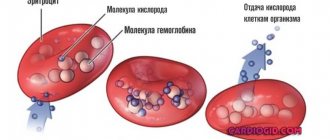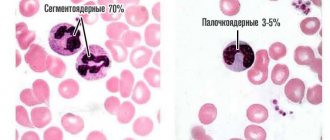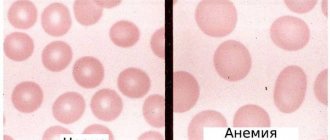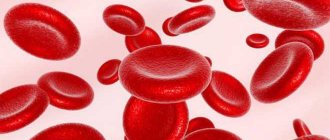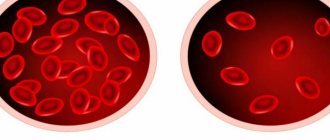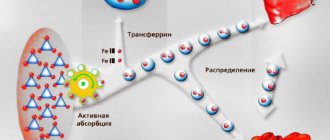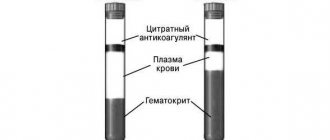Thrombocrit became known to doctors after the introduction of imported laboratory analyzers into practice. It is impossible to determine the indicator manually. It should not be confused with the long-known hematocrit. They reflect different components of blood. If hematocrit (ht) is used to judge the mass of red blood cells and its changes in relation to the liquid part, then thrombocrit indicates the proportion of platelets, the smallest formed elements.
Due to the use of analysis decoding equipment using terms in English, doctors had to get used to unusual abbreviations and norms. Thrombocrit is designated as platelet crit (PCT or pct). The parameter has not yet received proper practical use.
What does a deviation from the norm indicate?
Thrombocrit is the proportion of whole blood volume that is taken up by platelets (blood platelets).
Thrombocrit in the blood (platelet crit, PCT or pct) is an analogue of hematocrit (HCT), however, if the determination of hematocrit is still to some extent, albeit approximately, possible after spontaneous sedimentation of erythrocytes, then with thrombocrit this is not possible.
Outside the bloodstream, platelets, finding themselves on a foreign surface (for example, in a container intended for blood), receive pseudopodia, significantly increase in size (up to 10 times), then stick together and form aggregates.
This feature of platelets makes their examination problematic, as well as their storage for transfusion (it is necessary to maintain a state of rotation), therefore, in the case of thrombocrit, an automatic analyzer turns out to be indispensable.
Thrombocrit is not widely used.
Why do a thrombocrit test?
Why determine thrombocrit:
- Determining the patient's tendency to increased blood clots or bleeding.
- Thrombocrit can be used to assess the risk of possible complications when choosing preventive treatment.
Any physician should consider the platelet count in the study of his patient's blood clotting.
Typically, platelets are not included in the general indicators, and their analysis is carried out only at the request of doctors. This fact is due to the complexities of thrombocrit analysis technology.
The fact is that platelets have a special property: when moving into a “foreign” space, they grow almost tenfold due to the formation of pseudopodia (false legs). After this, the platelets stick together into aggregates - small particles.
This indicator correlates with the MPV indicator - this is the average volume of measured platelets: the higher the MPV indicator, the higher the thrombocrit (PCT), and accordingly, a decrease has the same effect on both indicators.
Thrombocrit is higher than normal: what does this mean?
Let us first examine under what circumstances the thrombocrit is higher than normal. This indicator can be high, it would seem, with two differently directed processes: with increased platelet production, and with a simultaneous decrease in blood plasma volume, or with hemoconcentration.
But if we were talking about blood thickening, then the hematocrit would first of all increase, by which it is much easier to determine the decrease in the volume of the liquid part of the blood.
Therefore, when increasing, we should only talk about an increase in the percentage of platelets, and not only to the total volume of blood, but also to the total volume of its cellular composition.
Thrombocrit is higher than normal in the following diseases and conditions:
- pathology of the red bone marrow, with activation of the platelet germ, or primary thrombocytosis and polycythemia. Such diseases, for example, include polycythemia vera, or Vaquez disease - erythremia. With this disease, all blood cells multiply very rapidly beyond the norm, and “thicken the blood.”
Secondary thrombocytosis occurs much more often, in which some diseases require activation of healthy bone marrow.
These include:
- oncological neoplasms,
- osteomyelitis,
- connective tissue diseases in the acute phase, such as rheumatoid arthritis and ulcerative colitis,
- hyperfunction of the thyroid gland with the development of thyrotoxicosis,
- diabetes,
- tuberculosis of bones and lungs,
- vascular atherosclerosis,
- conditions after operations and injuries,
- acute blood loss, hemolysis,
Also, high thrombocrit may be present for some time after splenectomy, or after removal of the spleen. They simply stop breaking down in the usual place, so for some time an increased number of platelets circulate in the blood.
It should be noted that thrombocrit is increased in children and adults for the same reasons: inflammatory processes, anemia, surgery, oncology, blood loss. There are no special “children’s reasons” for having a high thrombocrit.
What is the normal thrombocrit level?
In a general blood test, thrombocrit characterizes the content of platelet mass in whole blood, informing about an unacceptable increase or decrease in platelets in the patient.
If the thrombocrit is in the range from 0.15 to 0.4, then this means that it is normal (different sources indicate other normal values: 0.11 - 0.28, 0.12 - 0.38, 0.12 -0.36...).
Science does not distinguish between the norm of this indicator in an adult and an infant (that is, if the thrombocrit indicator is elevated in a child, this is not due solely to his age).
What is considered normal?
According to various sources, the lower limit of 0.11–0.15% is taken as the norm, and 0.28–0.40 as the upper limit. Over the years, a person’s platelets do not change, so the norms for children and adults are the same.
Physiological fluctuations are observed depending on the time of day and seasonality. In spring, thrombocrit may be 10% lower. A similar decrease is observed at night.
In women, the rate is reduced during heavy menstruation, as well as during pregnancy. This mechanism protects the body from possible blood clots.
Thrombocrit is increased during physical activity; athletes have PCT almost 2 times higher than normal.
With the addition of "relative width of cell distribution depending on volume", these three indicators form a group of platelet indices
When does thrombocrit increase?
The reasons for the increase in thrombocrit levels are associated with the reaction to pathology, stimulation of the platelet germ of hematopoiesis.
Most often, PCT values are elevated when:
- Iron deficiency anemia;
- After splenectomy (this is an operation to remove the spleen), the increase in PCT can persist for up to 2 months;
- Blood diseases that are associated with stimulation of the myeloid lineage (essential thrombocythemia, chronic myeloid leukemia, thrombocytopenic purpura, polycythemia);
- Inflammatory diseases of various etiologies (including fungal infections, bacteria);
- Tuberculosis;
- Hyperfunction of the thyroid gland;
- Viral attack (measles, flu, chicken pox in a child);
- Diabetes mellitus;
- Laboratory blood tests
Atherosclerosis of blood vessels;
- Osteomyelitis;
- Ulcerative colitis;
- Rheumatic attack;
- Fractures of tubular bones;
- In smokers – with nicotine intoxication;
- During a large-scale operation;
- Tissue necrosis (acute pancreatitis).
If an increase in this indicator is detected, the patient is at risk of developing:
- Thrombotic stroke (impaired blood supply to the brain).
- Acute thrombosis of coronary vessels with a probability of outcome in myocardial infarction.
The possibility of increased thrombosis should be taken into account when:
“Reading” blood: what factors influence the test result?
Useful articles / July 25, 2017
- A person begins taking a general blood test (CBC) from birth. Based on its results, it is possible to obtain information for the diagnosis of many diseases, assess their severity and monitor the dynamics of the treatment.
To evaluate the results of the OAC, special standards are used, but there are factors that influence the indicators. Can a person independently decipher the numbers of a general blood test? And what influences the deviation from the norm?
Manually or automatically?
In modern laboratories, not everything is yet subordinated to artificial intelligence. Yes, the vast majority of laboratories use automatic hematology analyzers to conduct a general blood test. In just a few minutes, the analyzer performs complex calculations of erythrocyte, leukocyte and platelet parameters. However, some defective cells may be identified incorrectly - destroyed, immature and deformed cells. In this case, a microscope is needed - on it the doctor examines the blood smear after examination with a hematoanalyzer.
“It cannot be said that a manual or automatic method of studying a general blood test is better; they complement each other,” comments Yulia KOCHKALDA, leading specialist in medical diagnostics . – Doctors working in the laboratory compare the indicators from the hemoanalyzer and microscopy, and if there is the slightest doubt, they will ask the patient to repeat the study.
What influences the result of the analysis?
Sometimes it happens that the result of a blood test differs from the norms that the patient can independently find on the Internet. The numbers vary for various reasons and do not always mean deviations in the body’s functioning. Therefore, we recommend that you do not engage in “blood reading” on your own and guess what this or that indicator means. Entrust the interpretation of the analysis to doctors and do not jeopardize your own health. But be sure to remember four factors that can distort a general blood test:
Physical exercise . It doesn’t matter whether a person has been involved in sports or for how long. The main thing is to be at rest 30-40 minutes before the test. It is advisable to limit exercise the day before blood sampling. Eating. It is not recommended to eat food earlier than 8 hours before the test. The day before donating blood, we advise you to exclude fatty and spicy foods from your diet. Menstruation. During critical days, a woman’s platelet count decreases. To avoid getting a false test, reschedule your blood donation to another day of your cycle. Taking medications . Many drugs affect the test result. Therefore, on the day of donating blood, do not take any medications; it is recommended to give up even vitamins. Before taking blood, consult your doctor; some medications should not be taken several days before the test.
Alarm bell: what does blood “say”?
What do changes in the general blood test signal?
What diseases may this indicate? We do not recommend making a diagnosis yourself based on a blood test. However, after consulting with a doctor, you can give yourself a “tour” of your own body and pay attention to the processes occurring in it. erythrocytes
| COMPONENTS | INCREASE | DEMOTE |
| erythrocytes | polycythemia; stay in the mountains; heart diseases; tumors that produce erythropoietin; stress; smoking; blood concentration during dehydration. | anemia; hemolytic crisis; renal failure; blood loss; bone marrow aplasia; influence of toxic substances and medications. |
| HEMOGLOBIN | polycythemia; staying at high altitude; conditions associated with hypoxia; tumors producing erythropoietin; stressful conditions; dehydration. | for all types of anemia; hemolysis of red blood cells; renal failure; bleeding; red bone marrow aplasia; taking certain medications; pregnancy. |
| HEMATOCRIT | prolonged hypoxia, dehydration, leukemia, tumor processes in the kidneys. | anemia, hyperhydration, hyperproteinemia, pregnancy. |
| MCV (mean erythrocyte volume) | B12 and folate deficiency anemia, kidney disease, alcohol abuse, myxidema, bone marrow aplasia, reticulocytosis, use of anticonvulsants. | with iron deficiency; hemoglobinopathies (thalasemia); anemia in chronic diseases; sideroblastic anemia; lead poisoning. |
| MCH (hemoglobin content in red blood cells) | hyperchromic and megaloblastic anemia, hypothyroidism, liver diseases, cancer. | long-term lead intoxication, thalassemia, hypovitaminosis B12, chronic inflammatory processes, iron metabolism disorders. |
| RETICULOCYTES | anemia; acute blood loss; anemia treatment. | aplastic anemia; anemia due to impaired maturation of red germ elements; liver diseases; condition after blood transfusion; chemotherapy. |
| NEUTROPHILS | for all bacterial infections; acute and chronic myeloid leukemia; generalized tumors; stressful conditions; with tissue necrosis; vasculitis; decompensation of diabetes mellitus; acidosis; taking lithium, glucocorticoids; adrenaline; for leukemoid reactions, sepsis, endocarditis, miliary tuberculosis and tumor metastasis. | with viral infection, aplastic anemia, radiation, agranulocytosis, immunosuppression, taking certain antibiotics, chemotherapy drugs, thyreostatics, analgesics, psychotropics. With lymphocytic leukemia and monocytic leukemia, there is a relative decrease in neutrophils. |
LYMPHOCYTES
| COMPONENTS | INCREASE | REDUCTION |
| LYMPHOCYTES | for chronic infections, tuberculosis, chronic limadenopathy, infectious mononucleosis, Hodgkin's disease, Addison's disease, idiopathic thrombocytopenic purpura. | for AIDS and related diseases, bone marrow damage after chemotherapy and radiation therapy, steroid treatment, Cushing's disease, aplastic anemia, neurological diseases. |
| MONOCYTES | for viral, parasitic and protozoal diseases, sarcoidosis, Crohn's disease, tumors. | for aplastic anemia, chronic lymphadenopathy, treatment with glucorticoids. |
| EOSINOPHILES | allergic diseases, bronchial asthma, parasitic infections, collagenosis, angioedema, Hodgkin's disease, skin diseases. | general decrease in immunity, extensive burns, infectious diseases, dysentery, acute appendicitis, stress, prolonged pain, intoxication of the body. Source: https://womanadvice.ru/eozinofily-ponizheny |
| BASOPHILES | chronic myeloid leukemia, hypothyroidism, mastocytomas and systemic mastotosis. | Infectious diseases, stress, pregnancy, Cushing's disease, hyperthyroidism, regular stress conditions, allergies with severe manifestations, active thyroid function, pneumonia, adrenal diseases. |
PLATELETS
| COMPONENTS | INCREASE | REDUCTION |
| PLATELETS | acute inflammatory processes in the intestines, conditions after removal of the spleen, myeloproliferative diseases, infections, blood loss, sideropenia, pancreatitis. | with enlarged spleen, liver cirrhosis, bone marrow damage, alcoholism, Helicobacter pylori infection, collagenosis, DIC syndrome, coagulopathies, septic conditions. |
| MPV (mean platelet volume) | idiopathic thrombocytopenic purpura, thyrotoxicosis, diabetes mellitus, myeloproliferative diseases, atherosclerosis, smoking, alcoholism. | splenectomy, Wiskott-Aldrich syndrome. |
| PCT (thrombocrit) | myeloproliferative diseases, splenectomy, iron deficiency in the body, viral diseases and inflammatory diseases of other etiologies, atherosclerotic process, diabetes mellitus, smoking. | apastic anemia, myelodysplastic syndrome, megaloblastic anemia, collagenosis, hemoblastosis, ionizing radiation, the use of certain medications, hematopoietic tissue tumors, intoxication, chronic renal failure, liver cirrhosis. |
| PDW (platelet distribution width by volume) | inflammatory process, anemia, postoperative period, blood loss. | myelodysplastic syndrome, leukemia, bone marrow metastases, thrombocytopenia, radiation sickness, chronic hepatitis. |
Why does thrombocrit decrease?
If the thrombocrit indicator is low, this indicates:
- Increased destruction;
- Inhibition of platelet formation by effects on megakaryoblasts (precursor cells).
Most often, low thrombocrit is due to the following reasons:
- Myelodysplastic syndrome;
- Anemia (megaloblastic and aplastic);
- Insufficient nutrition of folic acid, when its content is maintained below the required level for a month or more;
- Allergic diseases;
- Lupus erythematosus, as well as other collagenoses;
- Consequences of a course of chemotherapy;
- Blood tumors (hemoblastosis, leukemia);
- Exposure to toxic substances;
- Penetrating radiation;
- Negative effects of medications (antibiotics, cytostatics, corticosteroids, diuretics);
- Chronic renal and liver failure;
- Viral infections.
It is found during fetal asphyxia and in low-weight newborns. In older people, a connection between low thrombocrit and exposure to helminthiasis (parasitic infection) has been proven.
A dangerous consequence for the patient’s life can be his tendency to bleed, since any, even minor injuries can cause large blood loss. The most severe manifestation may be hemorrhage in the brain and other organs.
Reasons for low pct
A doctor may necessarily prescribe a patient to donate blood for pct in the following cases:
- when diagnosing sepsis in order to clarify the severity of the ongoing process;
- in case of suspected bacterial or viral infections that lead to the general serious condition of the patient;
- febrile state of unknown origin;
- in case of infectious complications during organ transplantation;
- when connecting a patient to a ventilator;
- to understand what treatment to prescribe if the patient is immunosuppressed.
To take a thrombocrit test, both an adult and a child must follow the following rules:
- It is advisable to donate blood on an empty stomach before 9 am;
- Before taking the test, do not drink alcoholic beverages the day before, do not eat fatty, salty, or spicy foods;
- it is advisable not to smoke before the analysis, because this action may cause changes in thrombocrit;
- It would be best not to take any medications the day before OAC, but if you still need to take them, you should definitely notify your doctor;
- Women need to correlate their menstrual cycle with the test.
If the results of the analysis show that the thrombocrit is low, then you should not immediately try to prescribe treatment for yourself - this should be done by a qualified specialist, taking into account all the possible causes of this phenomenon.
READ The content of red blood cells in the blood is increased - what does this mean?
Video:
A condition in which a person has a persistently low thrombocrit is observed in approximately two percent of the world's population and most often refers to chronic blood diseases characterized by low coagulation.
A platelet level below normal values indicates that few platelets are synthesized in bone tissue, and they are quickly destroyed.
The reasons that a person has a low thrombocrit may be the following pathologies:
- anemia of various kinds, both megaloblastic and aplastic;
- autoimmune diseases (lupus erythematosus). In this case, the immune system, for some reason, marks platelets as cells harmful to the body and destroys them;
- disruption of bone marrow production of platelets;
- insufficient amounts of folic acid and vitamin B12 in the diet;
- oncological blood diseases;
- liver hemangioma;
- taking medications that thin the blood for a long time;
- poisoning of the body with various kinds of toxins, both when working in hazardous industries, and as a result of radiation or chemotherapy;
- state of chronic renal failure;
- liver cirrhosis and viral hepatitis;
- allergic diseases;
- damage to the body by worms.
If a child had a low weight at birth (less than 2.5 kg) and had breathing problems, then the thrombocrit in this case is often below normal.
Children may demonstrate low thrombocrit if they take a course of antibacterial and diuretic drugs after suffering viral and bacterial infections.
Taking corticosteroid and cytostatic drugs can also cause a decrease in pct.
Manifestations of changes in thrombocrit levels
It is mandatory for the attending physician to prescribe a blood test for thrombocrit if there is a suspicion of the above diseases.
You should be aware of symptoms that may be associated with a decrease or increase in platelet count.
The patient has:
Feeling worse
Additional examinations if thrombocrit changes
To diagnose the disease, it is important to determine the cause of changes in thrombocrit levels. And a general blood test may not be sufficient for this.
Checked:
- Blood collection
Bleeding time;
The doctor prescribes to the patient:
- Hardware studies using radiography and ultrasound.
- To check the patency of blood vessels, Doppler examination is indicated.
- If certain symptoms are detected, magnetic resonance imaging of the brain is prescribed.
- If there is a suspicion of a blood disease, a bone marrow puncture is prescribed.
- The correctness of the hematopoiesis process is checked.
Additional Research
If a person has an increased or decreased thrombocrit in the blood, additional tests will be prescribed. Which ones? The time it takes for the blood to clot is recorded. Additional tests will “tell” about the presence of protein and sugar in the blood and indicate the exact amount of iron. An examination for the presence of fibrinogen will also be carried out; often the patient will be prescribed a urine test, and we are talking about an expanded type of analysis, and if necessary, a referral may be issued for a test for the content of hormones in the body and tumor markers.
Doctors often write out a referral for an echogram, as well as an x-ray of the kidneys, liver and spleen. To understand how well the blood vessels function, it is necessary to do a Doppler ultrasound. If there is a suspicion that there is a blood disorder in the body, a bone marrow biopsy will be taken. Tissues are also often examined for the content of certain types of cells.
Prevention in case of changes in thrombocrit values
If the thrombocrit is elevated, the doctor prescribes:
Their intake is necessary to reduce the risk of vascular thrombosis.
The duration of the course and dosage are determined by the attending physician. You cannot increase the dose or stop taking it on your own.
You should consult your doctor about the advisability of taking hormonal birth control and the need for diuretics.
The patient is recommended:
- Stop smoking.
- Avoid alcoholic beverages.
- Drink clean filtered water in an amount of at least two liters/day.
- The daily diet should include:
- Onion;
- Garlic;
- Fish;
- Lemons;
- Tomatoes;
- Vegetable flaxseed oil;
- Fruits and berries;
- Meat;
- Beef;
- Buckwheat;
- Liver;
- Dairy products;
- Seafood.
Not recommended:
- Bananas;
- Lentil porridge;
- Walnuts;
- Pomegranates and mangoes;
- Drinks with chokeberry.
If your thrombocrit level decreases, you should include in your diet:
- Vegetables and fruits;
- Be sure to eat fish or meat dishes every day;
- Fresh juices with viburnum, cranberries, sea buckthorn.
It is not recommended to consume products containing acetic acid and preservatives. Homemade preparations are also harmful to the body. You will have to exclude all kinds of allergens (citrus fruits, honey, eggs, chocolate).
To maintain normal thrombocrit, the patient is recommended to:
- Reduce the likelihood of minor injuries.
- Limit physical activity.
- Organize sufficient sleep and rest.
- Refuse vaccinations.
The specific need for a course of treatment when thrombocrit changes is determined by the doctor. If the listed symptoms are detected, you should not self-medicate. Common folk remedies are more likely to harm than help.
Having spent time selecting the “best” treatment method, the patient loses the opportunity to use the minimum doses of necessary drugs, which worsens the prognosis.

